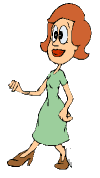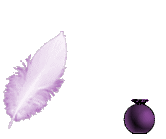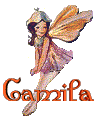 |
| VERB TO BE - GRAMMAR VERB TO BE
|
|
|

 GRAMMAR VERB TO BE GRAMMAR VERB TO BE
|
The Indicative Mood
1) Present Simple Tense
1.1 The verb to be
Forms:
a) Positive
| |
|
|
|
contracted forms
|
|
I
|
am
|
Daniel
here
20 years old
|
|
I ‘am
|
|
You
|
are
|
Camila
in the park
15 years old
|
|
You’re
|
|
He
|
is
|
Luke
at home
cold
|
|
He’s
|
|
She
|
is
|
Mary
in her room
hot
|
|
She’s
|
|
It
|
is
|
a dog
in the garden
hungry
|
|
It’s
|
|
We
|
are
|
friends
|
|
We’re
|
|
They
|
are
|
|
|
They’re
|
b) Negative
| |
|
|
contracted forms |
|
I
|
am
|
not
|
m’not
|
|
You
|
are
|
not
|
re’not
|
|
He
|
is
|
not
|
is’not
|
|
She
|
is
|
not
|
is’not
|
|
It
|
is
|
not
|
is’not
|
|
We
|
are
|
not
|
re’not
|
|
They
|
are
|
not
|
|
Some uses of this verb are:
a) To indicate a name, profession, pastime etc of the subject. Or simply to name things:
Examples:
I am Caroline 
He is a dancer 
She is an actress 
They are Peter and Paul
It is a plane!
They are sun glasses
b) To indicate a position in space or time:
Examples:
I am here…
They are in the classroom
c) To indicate a quality or a state:
Examples:
She is beautiful
Life is unfair  He is ten years old
She is all right now
The world is round
d) To indicate possession:
Examples:
This house is mine 
It`s John ‘s money
It`s yours
e) To introduce some adverbials of time:
Examples:
It`s late  It`s very early
f) To indicate where people come from:
Examples:
She is from Colombia
 You are from Brazil
|
El Modo Indicativo
1) Tiempo Presente Simple
1.1 El verbo ser, estar, tener
Formas:
a) Positiva
| |
|
|
|
|
|
Yo
|
soy
|
Daniel
|
estoy
aquí
|
tengo
20 años
|
|
Tu
|
eres
|
camila
|
estás
en el parque
|
tienes
15 años
|
|
El
|
es
|
Lucas
|
está
en casa
|
tiene
frío
|
|
Ella
|
es
|
Mary
|
está
en su cuarto
|
tiene
calor
|
|
|
es
|
un perro
|
está en el jardín
|
tiene
hambre
|
|
Nos
|
somos
|
amigos
|
estamos
|
tenemos
|
|
Ellos
|
son
|
|
están
|
tienen
|
b) Negativa
| |
|
|
|
|
|
Yo
|
no
|
soy
|
estoy
|
tengo
|
|
Tu
|
no
|
eres
|
estás
|
tienes
|
|
El
|
no
|
es
|
está
|
tiene
|
|
Ella
|
no
|
es
|
esta
|
tiene
|
|
Esto
|
no
|
es
|
esta
|
tiene
|
|
Nos
|
no
|
somos
|
etc
|
etc
|
|
Ellos
|
no
|
son
|
estan
|
|
Algunos usos de este verbo son:
a) Para indicar un nombre, profesión, pasatiempo etc del sujeto. O simplemente para nombrar cosas:
Ejemplos:
Soy Carolina
Es bailarin
Es actriz 
Son Peter y Paul
Es un avión!
Son anteojos de sol
b) Para indicar posición en espacio o tiempo:
Examples:
Estoy aquí
Mary está en el jardín
Están en el aula 
c) Para indicar una cualidad o estado:
Ejemplos:
Es hermosa
La vida es injusta
Tiene diez años
(ella) ahora está bien
La tierra es redonda 
d) Para indicar posesión:
Ejemplos:
Esta casa es mía
Es el dinero de John
Es suyo /tuyo
e) Para dar introducción a algunos adverbios de tiempo:
Ejemplos:
Es tarde
Es muy temprano
f) Para indicar la procedencia u origen de las personas:
Ejemplos:
Ella es de Colombia
Tu eres de Brasil
|
|
c) Interrogative
yes/ no Questions (short questions)
|
Am
|
I
|
Laura
here
20 years old
|
?
|
|
Are
|
you
|
Peter
in the park
15 years old
|
?
|
|
Is
|
he
|
Luke
at home
cold
|
?
|
|
Is
|
she
|
Mary
in her room
hot
|
?
|
|
Is
|
it
|
a dog
in the garden
hungry
|
?
|
|
Are
|
we
|
friends
|
?
|
|
Are
|
they
|
twins
|
?
|
Yes / no Answers (short answers)
|
Yes,
|
I
|
am
|
No,
|
am
|
not
|
|
Yes,
|
I
|
am
|
No,
|
am
|
not
|
|
Yes,
|
he
|
is
|
No,
|
he
|
isn’t
|
|
Yes,
|
she
|
is
|
No,
|
she
|
isn’t
|
|
Yes,
|
it
|
is
|
No,
|
it
|
isn’t
|
|
Yes,
|
we
|
are
|
No,
|
we
|
aren’t
|
|
Yes,
|
they
|
are
|
No,
|
they
|
aren’t
|
d) Interrogative
Wh questions
Some examples of wh questions with this tense
|
What
time
colour
|
is
are
is
are
|
your name
it
this
that
your phone number
his favourite sports
they
it
your eyes
|
?
|
|
Where
|
is
are
|
he from
they from
|
?
|
|
When
|
is
|
your birthday
|
?
|
|
How
old
|
is
are
are
|
your mum
you today
you
|
?
|
|
Why
|
is
|
he sad
|
?
|
|
Which
|
is
|
your jacket
|
?
|
|
Who
|
is
|
your best friend at school
|
?
|
|
Whose
house
car
|
is
|
this
that
|
?
|
|
c) Interrogativa
Preguntas sí/ no (preguntas cortas)
|
¿Soy
|
Laura?
|
¿Estoy
|
aquí?
|
¿Tengo
|
20 años?
|
|
¿Eres
|
Peter?
|
¿Estás
|
en el parque?
|
¿Tienes
|
15 años?
|
|
¿Es
|
Luke?
|
¿Está
|
en casa?
|
¿Tiene
|
frío?
|
|
¿Es
|
Mary?
|
¿Está
|
en su cuarto?
|
¿Tiene
|
calor?
|
|
¿Es
|
un perro?
|
¿Está
|
en el jardín?
|
¿Tiene
|
hambre?
|
|
¿Somos
|
amigos?
|
|
|
|
|
|
¿Son
|
gemelos?
|
|
|
|
|
Respuestas sí /no (respuestas cortas)
|
Sí,
|
soy estoy tengo
|
|
No,
|
soy estoy tengo
|
|
Sí,
|
soy estoy tengo
|
|
No,
|
soy estoy tengo
|
|
Sí,
|
es está tiene
|
|
No,
|
es está tiene
|
|
Sí,
|
es está tiene
|
|
No,
|
es está tiene
|
|
Sí,
|
es está tiene
|
|
No,
|
es está tiene
|
|
Sí,
|
somos estamos tenemos
|
|
No,
|
somos estamos tenemos
|
|
Sí,
|
son están tienen
|
|
No,
|
son están tienen
|
d) Interrogativa
Preguntas wh
Algunos ejemplos de preguntas wh en este tiempo verbal
|
¿Cuál es tu nombre? Carina... ¿Qué es?
¿Qué es esto?
¿Qué es eso?
¿Cuál es tu número de teléfono?
¿Cuáles son sus deportes favoritos?
¿Qué son?
¿Qué hora es?
¿De que color son tus ojos?
|
|
¿De dónde proviene /es?
¿De dónde son?
|
|
¿Cuándo es tu cumpleaños?
|
|
¿Cómo está tu mamá?
¿Cómo estás hoy?
¿Cuántos años tienes?
|
|
¿Por que está triste?
|
|
¿Cuál es tu saco?
|
|
¿Quién es tu mejor amigo en la escuela?
|
|
¿De quien es esta casa?
¿De quien es este auto?
|
|
| INFINITIVO |
PRETERITO |
PARTICIPIO |
To be
ser, estar |
Was , were
fui, era |
Been
sido, estado |
El verbo 'To be' tiene una importancia especial en inglés. Se corresponde a los verbos españoles "ser" y "estar". Dependiendo del sentido de la frase deduciremos de cual de los dos se trata.
I am English / Soy inglés
I am in England / Estoy en Inglaterra
Tiene algunos usos especiales distintos a sus equivalentes españoles.
- Sirve para expresar la edad, en cuyo caso se traduce por 'tener':
Mary is 20 years old / Maria tiene 20 años
I am 21 / Yo tengo 21 años
How old are you? / ¿Cuántos años tienes?
- Para expresar las sensaciones también se emplea el verbo 'to be' y equivale al 'tener' español.
Are you hungry? / ¿Tienes hambre?
He is thirsty / Tiene sed
- También para hablar sobre el tiempo atmosférico. En este caso se traduce por 'hacer'
It's windy / Hace viento
It's very cold / Hace mucho frío
PRESENTE DE INDICATIVO
| FORMA AFIRMATIVA |
FORMA NEGATIVA |
FORMA INTERROGATIVA |
| I am (I'm) |
I am not (I'm not) |
am I? |
| soy, estoy |
no soy, no estoy |
¿soy yo?, ¿estoy yo? |
| you are (you're) |
you are not (you're not) |
are you? |
| eres, estás |
no eres, no estás |
¿eres tú?, ¿estás tú? |
| he is (he's) |
he is not (he's not) |
is he? |
| él es, está |
él no es, no está |
¿es él?, ¿está él? |
| we are (we're) |
we are not (we're not) |
are we? |
| somos, estamos |
no somos, no estamos |
¿somos?, ¿estamos? |
| you are (you're) |
you are not (you're not) |
are you? |
| sois, estáis |
no sois, no estáis |
¿sois?, ¿estáis? |
| they are (they're) |
they are not (they're not) |
are they? |
| ellos son, están |
ellos no son, no están |
¿son, están ellos? |
PRETERITO (se corresponde al pretérito indefinido y al pretérito imperfecto español)
| FORMA AFIRMATIVA |
FORMA NEGATIVA |
FORMA INTERROGATIVA |
| |
|
|
| I was |
I was not (I wasn't) |
was I? |
| fui, era / estuve, estaba |
no fui, no era / no estuve, no estaba |
¿fui?, ¿era? / ¿estuve?, ¿estaba? |
| you were |
you were not (you weren't) |
were you? |
| fuiste, eras / estuviste, estabas |
no fuiste, no eras / no estuviste, no estabas |
¿fuiste?, ¿eras? / ¿estuviste?, ¿estabas? |
| he was |
he was not (he wasn't) |
was he? |
| fue, era / estuvo, estaba |
no fue, no era / no estuvo, no estaba |
¿fue?, ¿era? / ¿estuvo?. ¿estaba? |
| we were |
we were not (we weren't) |
were we? |
| fuimos, éramos, / estuvimos, estábamos |
no fuimos, no éramos, / no estuvimos, no estábamos |
¿fuimos?, ¿éramos? / ¿estuvimos?, estábamos |
| you were |
you were not (you weren't) |
were you? |
| fuisteis, erais, / estuvisteis, estabais |
no fuisteis, no erais / no estuvisteis, no estabais |
¿fuisteis?, ¿erais?, / ¿estuvisteis?, ¿estabais? |
| they were |
they were not (they weren't) |
were they? |
| fueron, eran / estuvieron, estaban |
no fueron, no eran / no estuvieron, no estaban |
¿fueron?, ¿eran? / ¿estuvieron?, ¿estaban? |
En el Presente, las formas afirmativa y negativa se pueden contraer, mientras que en la forma interrogativa no. En el pretérito solamente la forma negativa puede contraerse.
Las formas contraidas suelen utilizarse en la conversación, pero no se usan de forma escrita salvo cuando el propio escrito tiene un carácter informal o refleja una conversación.
TO BE + INFINITIVO
Cuando al verbo 'to be' le sigue un infinitivo adquiere una importancia especial:
- Es una forma de dar instrucciones u órdenes de manera impersonal.
She is to stay here till we return / Ella debe quedarse aquí hasta que volvamos
(en lugar de 'She must stay....')
- Sirve para establecer un plan
She is to be married next year / Ella va a casarse el año próximo
TO BE + GOING TO
Expresa una forma de futuro. Equivale a las expresiones españolas "ir a..., estar punto de... tener la intención de..., etc."
We are going to the theatre tonight / Vamos al teatro esta noche
I am going to travel to Buenos Aires next Monday / Tengo la intención de viajar a Buenos Aires el próximo lunes.
|
| Hoy habia 2 visitantes (12 clics a subpáginas) ¡Aqui en esta página!
|
|
|









 GRAMMAR VERB TO BE
GRAMMAR VERB TO BE






























